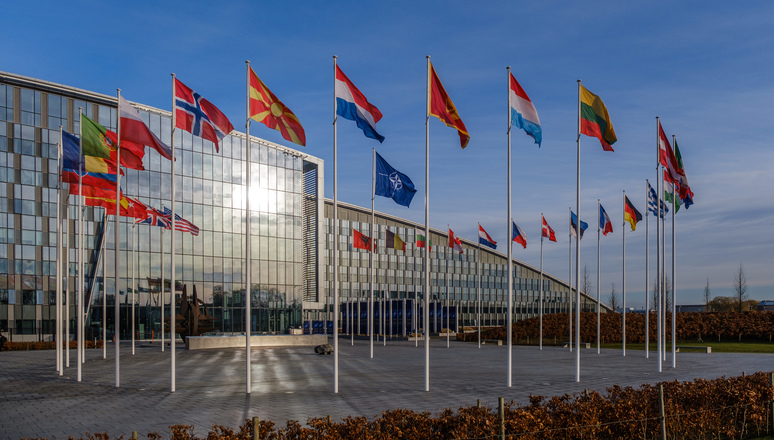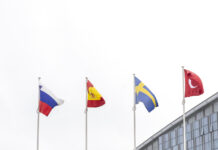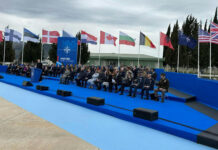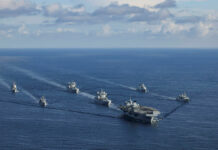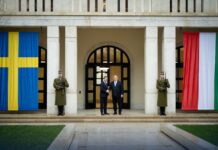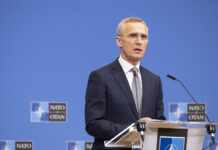The War in Ukraine brutally put military issues at the top of EU countries’ agendas again, boosting European defence budgets after more than a decade of under-investment. In a scenario that might seem ideal for affirming autonomous EU defence cooperation, NATO and the US will instead likely be the big winners.
In a long interview given to The Economist in 2019, French President Macron said that “what we are currently experiencing is the brain death of NATO”. Until 2022, the scenario he described appeared relatively close to reality.
Russia was somehow perceived as less of a threat despite the annexation of Crimea in 2014, thus depriving the Alliance of its historical enemy. Since his 2016 election, President Trump harshly criticised NATO and its European members. Indeed, he considered that the US should no longer act as the “world policeman”, and that US funding to the Alliance was too high compared to European contributions. In particular, he pointed to the inability of most members to meet the NATO goal of spending two per cent of GDP in defence, as agreed in 2014. Moreover, Trump mainly followed a domestic agenda during his Presidency, with the notable exception of the commercial war with China. The arrival of President Biden in 2020 reassured Allies concerning reliability but did not bring substantial changes in Washington’s political focus, at least for the first year. Additionally, the hasty withdrawal from Afghanistan, which constituted the bulk of NATO’s military missions, seemed to bring the organisation’s purpose into question.
However, the destiny of the organisation has radically changed on 24 February 2022, with the Russian invasion of Ukraine. The first conflict waged in Europe and involving a nuclear power since the end of the Cold War has suddenly revived NATO, which has regained its original scope with the return of its historical enemy. The crisis has also demonstrated that the EU is far from being ready to have an autonomous defence policy, despite years of work.
EU Efforts to Gain Autonomy
European cooperative efforts have strongly increased in recent years, mainly driven by France, for whom strategic autonomy from the US is a mantra.
Since 2018, the Capability Development Plan (CDP) has been in place to prioritise military capabilities that need to be commonly addressed and developed. The Permanent Structured Cooperation (PESCO) and/or the European Defence Fund (EDF) provide a legal framework and specific funds for the development of joint capabilities. About 60 programmes have been launched under PESCO in the last few years, while requests for proposals to receive EDF funding are multiplying.
This dynamic is interesting, insofar as it reaffirms the political willingness to cooperate, however its impact has been limited so far, mainly due to the bottom-up approach taken. Groups of companies and states put projects forward, mainly driven by the possibility of using EU funding for various national purposes, from the preservation of occupational levels to the requirements of national armed forces, to serving national foreign policy objectives.
Programmatic documents identifying common EU objectives – a crucial precondition for a common defence policy – do exist in theory. In the founding strategic documents of the most recent cooperative efforts, the 2016 Global Strategy and the 2022 Strategic Compass, the EU clearly affirms the willingness to step up its international ambitions.
However, the documents’ role within relevant international organisations, in particular NATO, remains unclear. While reaffirming the need for an EU defence policy to serve an EU agenda, the two documents nonetheless recognise the importance of NATO for EU defence. A comparison of the two texts suggests that the EU’s willingness for developing an EU pillar within NATO was stronger in 2016 than in 2022. Both documents stress that synergies should be built on the full respect of the institutional frameworks and the “decision-making autonomy” of the two organisations. However, the 2016 version clearly states that “[…] the EU needs to be strengthened as a security community: European security and defence efforts should enable the EU to act autonomously while also contributing to and undertaking actions in cooperation with NATO. A more credible European defence is essential also for the sake of a healthy transatlantic partnership with the United States.” On the other hand, the 2022 Strategic Compass states that “The EU will also help to strengthen NATO and become a stronger Transatlantic partner: a partner that is more capable of sharing the burden of maintaining international peace and security”. In the following line, the document, approved in March 2022, also adds that “Russia’s aggression against Ukraine has shown both how essential NATO is for the collective defence of its members and the important role that the EU plays in today’s complex security and defence environment”.
As will be discussed further, the war in Ukraine has been a gamechanger for both NATO and the EU.
The War in Ukraine
Six months after its beginning, the war seems far from over, and its likely outcome remains unclear. Russia failed to meet its original objective of a rapid invasion of the country, in part because it underestimated Ukrainian resistance. As we write, the conflict is evolving towards a war of attrition, in which the risk of nuclear incident remains high due to skirmishes around the Zaporizhzhia nuclear power plant (NPP). The War in Ukraine has served as a notable example of why a post-NATO EU is still far from being achievable.
As already mentioned, the EU has been working on reinforcing defence collaborations for years. The first cooperative R&D projects have been launched, thanks to the first investments under different defence-related funds. A brand-new strategic framework is in place, and political consensus regarding the need for a “geopolitical” EU is probably at a record high level. A war at the gates of Europe could have been the perfect occasion to demonstrate the progress the EU has made on foreign policy and defence.
From a political perspective, EU countries succeeded in showing unity against Russia. They were able to rapidly approve a significant package of sanctions, welcome Ukrainian refugees in Europe thanks to the first ever activation of the Temporary Protection Directive, and to approve assistance measures under the European Peace Facility (EPF). The total amount of assistance has reached EUR 2 billion since the start of the war, of which €490m was for “military equipment designed to deliver lethal force for defensive purposes” and €10m to “cover the provision of equipment and supplies, such as personal protective equipment, first aid kits, and fuel”.
In relative terms, these provisions represent an unprecedented EU effort, as significant military aid was approved, and more quickly than usual. In absolute terms, however, the EU is progressing too slowly, and its aid is less effective compared to what the other stakeholders have delivered, thus having a limited military impact on the battlefield. Given that battlefield equipment is very high on Ukraine’s list of priorities, this
In particular, EU countries are struggling to pledge promised armaments, mainly due to their relative lack of excess equipment in storage. For some Western European countries, in particular Germany, sending weapons to Ukraine means accepting a shortage in specific systems. This is a dangerous situation, as self-defence capabilities must be preserved considering the war is ongoing and could escalate further.
According to the “Ukraine support tracker” from the Kiel institute for the world economy, the “gap between committed and disbursed aid has narrowed” for large EU countries between January and August 2022. To take some examples, Poland has already delivered the promised €1.8Bn in equipment, while Germany has delivered only EUR 290 million out of the promised €620m. In the reference period, EU institutions (including Commission, Council and EPF, but also Macro-Financial Assistance and the European Investment Bank) pledged €12.3Bn in financial aid and €2.5Bn in military aid.
Why are these figures relevant to assess whether an EU defence may exist outside NATO? Because, in the same period, the US pledged €10.3Bn in financial aid and €25Bn in military aid, greatly exceeding the EU’s figures. On 24 August, President Biden announced an additional package of about €3Bn, the largest since the beginning of the war. For its part, the UK has pledged €2.1Bn in financial aid and €4Bn in military aid, and has delivered nearly all the weapons systems it had committed to.
Taken together, the combined US and UK packages are much larger than the EU package, but also provide more support for Ukraine on the battlefield. The US weapons systems delivered, which include about 20 US High Mobility Artillery Rocket Systems (HIMARS), UAVs and other artillery systems, are having a more important impact than the 18 CAESAR self-propelled howitzers (SPHs) pledged by France or the PANZERHAUBITZE 2000 (PZH 2000) that Germany sent in July as its first delivery of heavy weapons since the beginning of the war.
Further Reasons Why a Post-NATO EU is Unlikely
A further obstacle to the development of an EU autonomous defence outside NATO is the need for the US nuclear umbrella. Following Brexit, France remains the only EU country possessing nuclear capabilities. Per the conditions set in 2009, when the country reintegrated into the Alliance’s command structure, the French nuclear deterrence is fully autonomous from NATO. Paris’ doctrine is based on the principle of strict sufficiency (“stricte suffisance”): the nuclear arsenal must have the lowest size allowing for maintaining a credible deterrent and protecting national security. The nuclear force will be used to inflict unacceptable damages to the enemy’s centres of power, in case of state-sponsored aggression against French vital interests, wherever it comes from, and in whatever form.
The assessment of these interests, as well as the final decision on whether using nuclear weapons, lies fully in the hands of the French President. This situation makes sharing the French nuclear umbrella with EU countries simply impossible, due to differences in foreign policy objectives. Having the French President decide to use nuclear weapons to protect Lithuania or Greece, but only after the approval of EU institutions and 26 national Parliaments could only be the scenario for a fiction novel.
As previously alluded to, the long-lasting and complex decision-making process is another main obstacle for taking meaningful foreign policy or military decisions. For instance, the EU has plenty of experience in military training missions, with 17 presently ongoing. However, EU defence ministers launched discussions on joint training mission for Ukrainian soldiers at the end of August, by which point British special forces had already trained 2500 out of the 10000 soldiers they had planned for.
Final Remarks
The war in Ukraine demonstrates that the US, and thus NATO, remain crucial for protecting EU security. The conflict has not only given new impetus to the Alliance but has shown the extent to which the EU is not prepared to autonomously protect its interests. The progress made so far on EU defence are big steps only from a European perspective, and in reality have had minimal military impact.
Moreover, the war in Ukraine finally convinced Finland and Sweden, who have been strong backers of EU defence so far, of the immediate need to join NATO to ensure their safety. With 23 out of the 27 EU members to be NATO members in the near future, and the war in Ukraine demonstrating the harm that years of under-investments had on the defence sector, the EU should finally abandon the idea of autonomous defence.
However, it might still be in a good position to create an EU pillar within NATO. To be successful, EU countries should effectively keep their promises in terms of increased defence budget, to maintain a constant production pace of defence materiel and to always have enough ready systems in their inventories.
The ongoing EU initiatives remain interesting, but their impact is limited. To really try to have a say within NATO, EU countries should at least establish specific, broadly shared, and consistent foreign policy objectives, as well as a prompt decision-making process and effective domestic military capabilities. So far, EU countries’ most recent attempt to counterbalance US decisions within NATO has failed. During the draft of the new Strategic concept, they were unable to impose the definition of China as “an economic competitor and a systemic rival”, which would have mirrored the one adopted in programmatic documents. Instead, Washington’s view of China as a challenge to “interests, security, and values,” was approved, thus marking the importance of the US’ pivot to Asia for the Alliance’s agenda. This was a clear sign that an EU pillar within NATO remains far from fait accompli.


